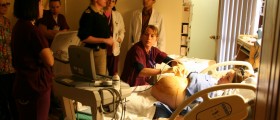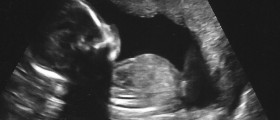
Ultrasound is a very commonly performed exam which controls the progression of pregnancy, confirms gender of the child and may also detect specific signs of certain diseases and disorders, such as Down syndrome. Doctors may recommend an ultrasound exam to determine the date of delivery or to seen whether there are several fetuses present (multiple pregnancies). Ultrasound may also be very helpful tool for prenatal testing of some genetic disorders.
How Does Ultrasound Work?
Ultrasound, as the name suggests, uses sound waves to generate the image of the child in mother’s womb. These sound waves cannot be heard by the human ear, but they can be utilized to see what is happening in mom’s belly. Depending on the density of the structures ultrasound waves come across in the belly (e.g. different bones, organs and tissues of the mother and the unborn child), these waves bounce back at different speeds. All returned sound waves are then collected in a computer, which then generates the image. The harder and more dense the structures in the belly are, the brighter will they look on the ultrasound image. Bones will, therefore, be bright white, the kidneys and the liver will be slight gray, while amniotic fluid is seen as completely black.
Doctors may use these ultrasound images to determine the sex but also to see if there are any abnormalities in the fetal anatomy.
Ultrasound and Down Syndrome
Ultrasound cannot confirm that the fetus has this syndrome, but it can be a screening test for any chromosome abnormalities, including Down syndrome.
Doctor may detect certain abnormalities or soft markers on the ultrasound image, suspecting that the unborn child has Down syndrome or some other disorder.
These soft markers are increased nuchal translucency and shorter than normal length of the femur (the thigh bone). The presence of choroid plexus cysts, intracardiac echogenic foci or echogenic bowel may also indicate Down syndrome. Other possible ultrasound findings which can make doctors suspect the child has Down syndrome include single umbilical artery and dilated renal pelvis.
After finding some of these soft markers on the ultrasound image of the unborn child, every pregnant woman (and her partner) should discuss the findings with their doctor and determine the possibility of having a child with Down syndrome and whether the woman should get further prenatal testing. Although many children may have some of these markers on the ultrasound, most of them are born perfectly healthy and without any genetic problems.

















Your thoughts on this
Loading...